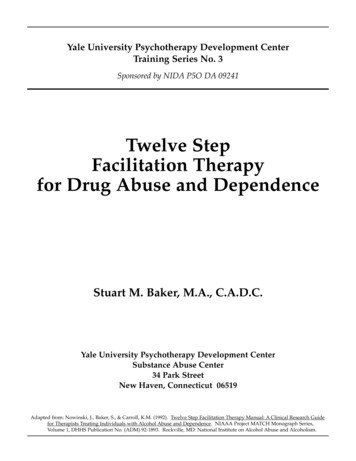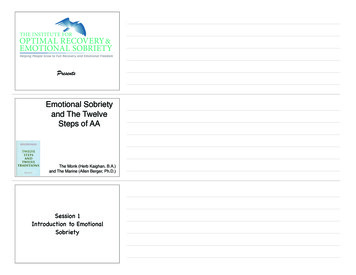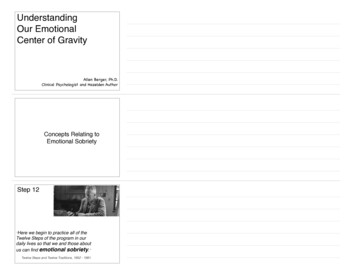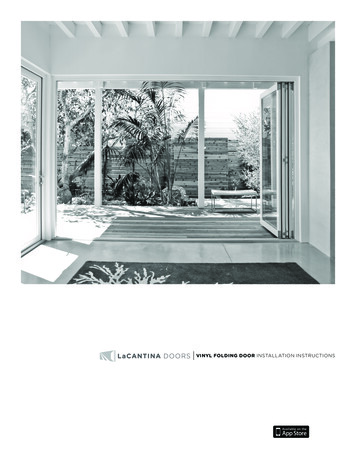
Transcription
Yale University Psychotherapy Development CenterTraining Series No. 3Sponsored by NIDA P5O DA 09241Twelve StepFacilitation Therapyfor Drug Abuse and DependenceStuart M. Baker, M.A., C.A.D.C.Yale University Psychotherapy Development CenterSubstance Abuse Center34 Park StreetNew Haven, Connecticut 06519Adapted from: Nowinski, J., Baker, S., & Carroll, K.M. (1992). Twelve Step Facilitation Therapy Manual: A Clinical Research Guidefor Therapists Treating Individuals with Alcohol Abuse and Dependence. NIAAA Project MATCH Monograph Series,Volume 1, DHHS Publication No. (ADM) 92-1893. Rockville, MD: National Institute on Alcohol Abuse and Alcoholism.
Editor: Kathryn F. Nuro, Ph.D.Training DirectorYale University Psychotherapy Development CenterGraphic Designer: Beverly F. PopeBiomedical Communications Department, Yale University
FORWARDThis manual reflects our work at the Yale University Psychotherapy DevelopmentCenter to understand and improve drug abuse treatment by specifying andevaluating innovative psychotherapies. This Twelve Step Facilitation (TSF) manualfor drug dependence reflects the work of numerous individuals who havecontributed to the series of clinical trials conducted at the Yale Substance AbuseTreatment Unit that have evaluated TSF in comparison to other treatments. Theseinclude, primarily, Stuart Baker, Art Woodard, and Dr. Joseph Nowinski, who, astherapists, supervisors, trainers, and authors, have fostered this exiting andpromising treatment approach.Other investigators contributing to the series of studies in which this approach hasbeen evaluated include: Bruce Rounsaville, M.D., Charla Nich, M.S., Sam Ball, Ph.D.,Elinor McCance, M.D., Ph.D., and the Project MATCH Research Group. The projectstaff and coordinators included Charla Nich, M.S., Tami Frankforter, JoanneCorvino, M.P.H., Monica Canning-Ball, Meghan Brio, Roseanne Bisighini, M.S.,Jennifer Owler, Lynn Gordon, R.N., and Kea Cox. We also gratefully acknowledgethe critical contributions of Drs. Pat Owen, Dan Anderson, and Fred Holmquist ofthe Hazelden Foundation in Center City, Minnesota, who consulted in thedevelopment of the original Project MATCH TSF manual.This manual describes an adaptation of Twelve Step Facilitation for use with drugdependent individuals. Major sources for this version of the manual include:Nowinski, J., Baker, S., & Carroll, K.M. (1992). Twelve Step Facilitation TherapyManual: A Clinical Research Guide for Therapists Treating Individuals withAlcohol Abuse and Dependence. NIAAA Project MATCH Monograph SeriesVolume 1, DHHS Publication No. (ADM) 92-1893. Rockville, MD: NationalInstitute on Alcohol Abuse and Alcoholism.Nowinski, J. & Baker, S. (1992). The Twelve Step Facilitation Handbook: ASystematic Approach to Early Eecovery from Alcoholism and Addiction.Lexington Books. An Imprint of Macmillan, Inc. New York.Nowinski, J. & Baker, S. (1998). The Twelve Step Facilitation Handbook. SanFrancisco: Jossey Bass.RESEARCH SUPPORTAlthough approaches similar to the treatment described here are in wide use in theclinical community, there was, until recently, very little empirical evidencesupporting their use (Holder et al., 1991; Miller et al., 1995). This occurred,primarily, because this type of approach had not been described in a form (i.e., adetailed treatment manual) necessary for evaluation in controlled clinical trials.This, and our other TSF manuals, are thus an important contribution to both the andresearch communities. Now that this approach has been manualized and we cantrain therapists to use it consistently, a number of important studies have recentlybeen completed that suggest this manualized TSF approach is very effective:First, in NIAAA-supported Project MATCH (Project MATCH Research Group, 1993,1997), the largest alcohol treatment trial ever done, involving over 1700 alcohol-
dependent individuals in 9 clinical research units across the country, TSF wasassociated with excellent retention and very good drinking outcomes. Moreover,TSF was found to comparable in effectiveness to Cognitive-Behavioral Therapy(CBT) and Motivational Enhancement Therapy (MET), two forms of treatment withstrong records of empirical support (Project MATCH Research Group, 1997).Furthermore, in the few instances where there were differences in outcome on somevariables (such as in rates of complete abstinence and negative consequences ofdrinking), these tended to favor the Twelve Step Facilitation approach over CBT andMET (Project MATCH Research Group, 1997). Although Project MATCH wasdesigned to detect patient-treatment interactions (matching effects), only onesignificant matching effect was seen, which also favored TSF: In the outpatient armof the study, clients low in psychiatric severity (as measured by the ASI) had moreabstinent days after TSF treatment than CBT; neither treatment was clearly superiorfor patients higher in psychiatric severity.Second, we have also used TSF in our recently completed trial of psychotherapy andmedication for cocaine-dependent patients who also abuse alcohol (Carroll et al.,1998). This twelve-week randomized clinical trial of disulfiram and three forms ofmanual-guided psychotherapy (TSF, CBT, and Clinical Management) indicated thefollowing: First, the two active psychotherapies, Cognitive-Behavioral Coping SkillsTherapy and Twelve-Step Facilitation, were more effective than ClinicalManagement, a psychotherapy control condition, in fostering longer periods ofconsecutive abstinence from cocaine, abstinence from both cocaine and alcoholsimultaneously, as well as a higher percentage of cocaine-free urine specimens.Moreover, the benefits of TSF and CBT compared with the minimal treatment weresustained through a one-year follow-up.The therapeutic approach underlying this manual is grounded in the principles andtwelve steps of NA/CA/AA. It is important to note, however, that this manual hasno official relationship with, or sanction from, any 12-Step program. The fellowshipof NA/CA/AA is described in official 12-Step program literature and is realizedthrough their worldwide meetings. NA/CA/AA do not sponsor or conductresearch into drug dependence or its treatment or endorse any treatment program.While intended to be consistent with 12-Step principles, this treatment program isdesigned for delivery in research protocols and in clinical settings. It’s goals are toeducate patients regarding the NA/CA/AA view of drug dependence and tofacilitate their active participation in NA/CA/AA.CAUTIONSThis manual, like any other, should not be used without appropriate training andongoing supervision. It may not be applicable to all patient types, nor compatiblewith all clinical programs or treatment approaches. This manual may supplement,but does not replace or substitute for the need for adequate assessment of eachpatient, careful case formulation, ongoing monitoring of patients' clinical status, orclinical judgment.Kathleen M. Carroll, Ph.D.Scientific DirectorYale University PsychotherapyDevelopment Center
ContentsChapter 1. Description, Goals, and OverviewDescriptionTreatment Goals and ObjectivesTSF Treatment OverviewSession FormatTechnical ProblemsChapter 2. Defining TSFActive Ingredients in TSF, Therapist Behaviors Prescribedand ProscribedEssential and Unique InterventionsRecommended but Not Unique InterventionsAcceptable InterventionsProscribed InterventionsCompatibility with Adjunctive TreatmentsTSF in Contrast to Other TreatmentsApprocahes Most Similar to TSFApproaches Most Dissimilar to TSFTable 2.1 Contrasts Between TSF and Other TreatmentsChapter 3. Core TopicsTopic 1: Introduction and AssessmentEstablishing RapportPrevious TreatmentDrug and Alcohol HistoryPatterns of Drug UseAssess Use of All Mood-Altering SubstancesPositive and Negative ConsequencesToleranceLoss of ControlOverview of TreatmentRecovery TasksWrap-upTroubleshootingTopic 2: Acceptance (Step 1)ReviewNew MaterialRecovery TasksWrap-upTroubleshootingTopic 3: People, Places, and Things (Habits and Routines)ReviewNew MaterialRecovery TasksWrap-upTroubleshootingTraining Series No. 62627282929323232353636393940414141i
Topic 4: Surrender (Steps 2 and 3)ReviewNew MaterialRecovery TasksWrap-upTroubleshootingTopic 5: Getting Active in 12-Step ProgramsReviewNew MaterialRecovery TasksWrap-upTroubleshootingChapter 4. Elective TopicsTopic 6: HIV Risk ReductionReviewNew MaterialRisky BehaviorsThe Serenity Prayer and UnmanageabilitySetting Risk Reduction GoalsRecovery TasksWrap-upTroubleshootingTopic 7: The GenogramReviewNew MaterialRecovery TasksWrap-upTroubleshootingTopic 8: EnablingReviewNew MaterialRecovery TasksWrap-upTroubleshootingTopic 9: EmotionsReviewNew MaterialRecovery TasksGrievingH.A.L.T.Wrap-upTroubleshootingTopic 10: Moral Inventories (Steps 4 and 5)ReviewNew Material (Steps 4 and 5): The Moral InventoryTSF Therapist Sets the ToneFacilitating a Moral InventoryRecovery 17276777777777979808081838383
Topic 11: Clean LivingReviewNew material: Living RecoveryRecovery TasksLiving RecoveryWrap-upTroubleshootingChapter 5. Termination ProcessTopic 12: TerminationReviewNew Material: TerminationTroubleshootingChapter 6. Conjoint ProgramConjoint Session 1: EnablingProgram Outline12-Step Program PrinciplesSignificant Other Substance cant Other Substance AbuseEmergency CallsConjoint Session 2: roubleshootingChapter 7. Therapist Selection, Training, and SupervisionTherapist Characteristics and Training RequirementsRole of TSF TherapistFamiliarity with 12-Step ProgramsActive and FacilitativeConfrontationTherapist TrainingRating and Assessment of Therapist Adherence andCompetenceCertification of TherapistsOngoing SupervisionGuidelines for Ongoing SupervisionCommon Problems Encountered in 01102102102102103104104105105109113iii
1. Description, Goals, and OverviewDescriptionBackground andRationale12-Step Facilitation Therapy (TSF) is a manual-guided treatment that wasdeveloped for use in psychotherapy research protocols for the treatment ofalcohol abuse and dependence. Since its initial development, the TSF manualhas been adapted for the treatment of drug abuse and dependence, includingpatients presenting with cocaine and opiate problems. The facilitation programin this manual is intended for use in brief, individual outpatient treatment forpersons who satisfy the DSM IV criteria for drug abuse or dependence. Theprotocol is designed to be used as primary treatment for patients who may havepreviously participated in Twelve Step programs, patients who have never beenexposed to Twelve Step programs, and/or patients who may or may not havehad previous substance abuse treatment.The program described in this manual is intended to be consistent with activeinvolvement in Twelve Step recovery programs such as Narcotics Anonymous(NA), Cocaine Anonymous (CA), and Alcoholics Anonymous (AA). It assumesthat addiction is a progressive disease of mind, body, and spirit, for which theonly effective remedy is abstinence from mood-altering substances, one day at atime. TSF adheres to the concepts set forth in the Twelve Steps and TwelveTraditions (Alcoholics Anonymous, 1981) of NA/CA/AA.The overall goal of this therapy is to promote abstinence by facilitating patients’active involvement and participation in the fellowship of 12-Step recoveryprograms (NA, CA, AA). Active involvement in 12-Step programs is regardedas the single most important factor responsible in maintaining sustainedrecovery from drug dependence, and therefore, is the desired outcome ofparticipation in this treatment.Disease ModelAccording to NA, addiction is a chronic, progressive illness which if notarrested, may lead to insanity or death. It is characterized by loss of the abilityto control (limit) the use of drugs. It is described here in Narcotics Anonymous(Narotics Anonymous, 1988):“At first, we were using in a manner that seemed to be social or at leastcontrollable. We had little indication of the disaster that the future heldfor us. At some point, our using became uncontrollable and anti-social.This began when things were going well, and we were in situations thatallowed us to use frequently. This was usually the end of the good times.We may have tried to moderate, substitute or even stop using, but wewent from a state of drugged success and well-being to completespiritual, mental and emotional bankruptcy. This rate of decline variesfrom addict to addict. Whether it occurs in years or days, it is alldownhill. Those of us who don’t die from the disease will go to prison,1
Yale University Psychotherapy Development Center Manual-Guided Training Seriesmental institutions or complete demoralization as the diseaseprogresses.” (Narcotics Anonymous, 1988, pp. 6–7)Drug addiction, like all chronic illnesses, has predictable effects on an individual(symptoms) and a predictable course. As noted above, in addition to thephysical aspects of addiction, the individual suffers psychologically, socially,and spiritually.Addiction to mood-altering substances is characterized by denial, or resisting toaccept the limitations of the addiction.“Many of us did not think that we had a problem with drugs until thedrugs ran out. Even when others told us that we had a problem, we wereconvinced that we were right and the world was wrong. We used thisbelief to justify our self destructive behavior.” (Narcotics Anonymous,1988, p. 5)Twelve-Step Recovery programs such as NA, CA, and AA are not a treatmentmethod, but a fellowship of peers connected by their common addiction andguided by the Twelve Steps and Twelve Traditions (Alcoholics Anonymous,1981). The only requirement to join the fellowship is a desire to stop usingmood-altering substances.12-Step programs make no commitment to a particular causal model ofaddiction rather they limit the concepts to those of loss of control and denial.From their roots in AA, 12-Step programs emphasize two themes: SPIRITUALITYBelief in a “power greater than ourselves”, which is defined individually,by each person, and which represents faith and hope for recovery. PRAGMATISMBelief in doing “what works” for the individual, meaning doing whatever it takes in order to avoid taking the first drug.Treatment Goalsand ObjectivesGoalsThis therapy program has two primary goals (which generally relate to the firstthree Steps of NA/CA/AA). These two goals are:AcceptanceThe breakdown of the illusion that the individual through willpoweralone can effectively and reliably control or limit his/her use of moodaltering substances. Acceptance by patients that they suffer from the chronic andprogressive illness of drug addiction. Acceptance by patients that they have lost the ability to control theiruse of mood-altering substances.2
1. Description, Goals, and Overview Acceptance by patients that since there is no effective “cure” foraddiction, the only viable alternative is complete abstinence from allmood-altering substances.Surrender Surrender involves a willingness to reach out beyond oneself and tofollow the twelve steps presented in 12-Step programs. Acknowledgment on the part of the patient that there is HOPE forRecovery, (sustained abstinence), but only through accepting thereality of the loss of control and by having faith that some HIGHERPOWER can help the individual whose own willpower has beendefeated by addiction to mood-altering substances. Acknowledgement by the patient that the fellowship of NA/CA/AAhas helped millions of addicts to sustain their recovery, therefore,the patient’s best chance for success is to follow the path ofNA/CA/AA.ObjectivesAs patients allow themselves to go through this process, they form the basis forearly recovery from addiction. The two major program goals are reflected in thefollowing objectives which are congruent with the NA/CA/AA view ofalcoholism and addiction:COGNITIVE Patients should understand some of the ways in which their thinking hasbeen affected by drug addiction. Patients should understand how their thinking may reflect denial(“stinking thinking”) and thereby contribute to continued drug use andresistance to acceptance (Step 1). Patients should see the connection between their drug use and negativeconsequences that result from it. These consequences may be physical,social, legal, psychological, financial, or spiritual.EMOTIONAL Patients should understand the NA view of emotions and how certainemotional states (anger, loneliness) can lead to drug use. Patients should be informed regarding some of the practical ways 12-Stepprograms suggests for dealing with emotions so as to minimize the risksof using drugs. TSF attempts to introduce and guide the individual in the use of 12-Stepprogram tools for dealing with such emotions as anger, loneliness, andgrief. These tools include making use of the program slogan “Don’t letyourself get too hungry, angry, lonely, or tired”. (H.A.L.T.)3
Yale University Psychotherapy Development Center Manual-Guided Training SeriesRELATIONSHIP Addiction has been described as a “disease of isolation”. TSF provides support for patient to beecome connected to 12-Stepprograms by going to meetings, participating in meetings andestablishing a relationship with a sponsor.BEHAVIORAL Patients should understand how the powerful and cunning illness of drugaddiction has affected their whole lives and how many of their existing orold habits (people, places and things) have supported their continueddrug use. Patients should replace people, places and things that threaten theirabstinence with people, places and things that support their recovery. Patients should turn to the fellowship of NA and to make use of itsresources and practical wisdom in order to change their addictivebehavior. Patients should “get active” in NA as a means of sustaining theirabstinence.SOCIAL Patients should attend and participate regularly in 12-Step meetings ofvarious kinds, including NA sponsored social activities. Patients should access NA whenever they experience the urge to use orwhen they slip or relapse. Patients should re-evaluate their relationships with “enablers” and fellowdrug users.SPIRITUAL Patients should experience hope that they can recover from their drugaddiction. Patients should develop a belief and trust in a power greater than theirown willpower. Patients should explore and re-evaluate their purpose in life. Patients should make a commitment to ethical and moral behavior, andacknowledge specific immoral or unethical acts, and harm done to othersas a result of their drug addiction.TSF TreatmentOverview4This treatment consists of 12 session topics which provide a structure and focusfor the treatment to be delivered as a time-limited, brief treatment. Typically,the treatment ranges from 12 to 24 weeks. Often a topic may need to becovered over several sessions, depending upon factors that may vary from
1. Description, Goals, and Overviewpatient to patient. In pacing the presentation of material, the therapist mayneed to assess, for example; (1) as a result of chronic and/or recent substanceuse, how cognitively available is the patient for treatment, (2) what level ofcommitment does the patient have to the treatment, (3) can a patientunderstand and retain a particular concept or idea?Each session is highly structured and has a specific agenda. Patients are askedto keep a personal journal, and recovery tasks are suggested each week to dobetween sessions.Central to this approach is strong encouragement to attend several differentkinds of 12-Step meetings per week and to read the 12-Step program literaturethroughout the course of treatment.Core TopicsTopics judged to be central to the treatment are presented first in the CoreProgram. These five core topics, discussed later in detail, should be delivered inthe following order for most patients:Topic 1: Introduction to Treatment and AssessmentTopic 2: AcceptanceTopic 3: People, Places, and Things (Habits and Routines)Topic 4: SurrenderTopic 5: Getting Active in 12-Step ProgramsElective TopicsThe Elective Program follows the Core Program. Depending on the needs of aparticular patient, several of these topics may be chosen for use in treatment.The Elective Program topics are:Topic 6: HIV Risk Reduction (recommended for all patients)Topic 7: The GenogramTopic 8: EnablingTopic 9: Emotions (H.A.L.T.)Topic 10: Moral InventoriesTopic 11: Clean LivingConjoint ProgramThe Conjoint Program is offered to those patients with a supportive significantother. The program includes two topics designed to involve the significantother in the patient’s recovery. Enabling Detachment5
Yale University Psychotherapy Development Center Manual-Guided Training SeriesTerminationThe final part of the Twelve Step Facilitation Therapy Program is the Terminationprocess. This consists of a session(s) which focus on changes and gains madeby the patient, as well as, plans for continued growth in recovery.It is intended that the core topics plus Termination be provided to all patients.There is more flexibility in the therapist’s use of the elective topics. Any core orelective session may be repeated if necessary to meet the needs of the patient.The use of a combination of core and elective topics allows this program todevelop individualized treatment plans within broad parameters. For example,it can be used with patients who have had no prior exposure to 12-Stepprograms and concepts, patients who have never participated in treatment ofany kind for drug addiction, and patients who have had one or more inpatienttreatment experiences plus extensive exposure to 12-Step programs.JournalsPatients are asked to maintain a personal journal, which is reviewed by thetherapist at the beginning of each session, and which is used to record thefollowing: All NA/CA/AA meetings attended (dates, times, places) Personal reactions to and thoughts about meetings Reactions to suggested readings Slips (occasions when the patient has used) and what was done aboutthem Reactions to recovery tasks Cravings or urges to use and how the patient managed themSession FormatTopic 1:Introduction andAssessmentTopics 2-116In the first session, the therapist introduces TSF and provides an overview ofthe treatment, including the goal of treatment, which is active involvement in12-Step programs. The therapist also helps patients evaluate their level of druginvolvement, introduces the 12-Step view of drug abuse and dependence, andattempts to motivate patients to stay clean and sober.Beginning with Session 2, the four additional core topics, as well as all electivetopics follow a prescribed format and structure known as the 20/20/20 rule(Carroll, K.M., 1998).
1. Description, Goals, and Overview20/20/20 RULE First Third of Session: ReviewAssess substance use, craving and dangerous people, places,and things, since last session.Listen for/elicit patient's current concerns.Review and discuss recovery tasks from previous week. Second Third of Session: New MaterialIntroduce and discuss new material.Relate session topic to current concerns. Final Third of Session: Recovery Tasks and Wrap-upSuggest recovery tasks for next week.Explore patient's understanding of and reactions to newmaterial.Review plans for upcoming recovery week. Carroll, K.M. (1998)ReviewUrgesSlips12-Step ToolsThis includes a review of the patient’s attempts at maintaining abstinence and areview of any slips, urges to use or thoughts about using, since the last session.Slips are handled by first examining the antecedents to the drug use, thensuggesting appropriate 12-Step tools that might have been employed to avoidthe slip (meetings, contacting sponsor/peers, reading of recovery materials).Slips should be treated non-judgementally and interpreted as times when thepower of the illness of drug dependence overcomes the patient’s willpower.MeetingsIt is essential that the therapist congratulate the patient for each clean andsober day and for their efforts to remain abstinent one day at a time. Thetherapist explores the patient’s reactions to any 12-Step meetings attended. Ifno meetings were attended, or the patient seems reluctant to attend meetings,the therapist explores this with the patient in an attempt to understand his/herresistance.ReadingsJournalA review of the patient’s reaction to assigned readings or audio tapes, etc., and areview of their journal, give the therapist an opening to assist the patient inworking through barriers that s/he may be experiencing in becoming activelyinvolved in 12-Step programs.Recovery TasksFinally, the therapist follows up on any other suggested recovery tasks such ascontacting a sponsor, taking on service work at a meeting, etc. This review ofthe week provides the patient a chance to talk about their day to day life andprovides the therapist with an opportunity to teach and encourage the use ofthe tools of 12-Step programs for dealing with life situations. This part of thesession takes approximately 20 minutes.7
Yale University Psychotherapy Development Center Manual-Guided Training SeriesNew MaterialFollowing the review, each session should move on to cover a specific topic.Using material presented by the patient during the review of the week, thetherapist can connect the patient’s personal experience to the new material forthe current topic. This tailors the session material specifically to the patient’sconcerns, making it more relevant for the patient. For example, the patient mayhave expressed frustration with the behavior of a co-worker or a boss. Thetherapist may wish to use this material to talk about the concept of“Powerlessness” and the first Step of NA, or about using 12-Step tools to handleemotions, etc. About 20 minutes are devoted to this section.Recovery TasksPreparation for staying clean and sober during the coming week (or periodbetween sessions) comes next. The therapist and patient discuss suggestedrecovery tasks which may include readings from recovery literature, listening torecovery tapes, or performing recovery related activities such as contactingrecovering peers or going to 12-Step related social activities, etc. Specificrecovery tasks include:MeetingsReadings A mutually agreed upon list of 12-Step meetings to be attended. Suggested readings from NA/CA/AA texts:Alcoholics Anonymous (Alcoholics Anonymous, 1976). “The BigBook”.Twelve Step and Twelve Traditions (Alcoholics Anonymous, 1981).“12x12”.Narcotics Anonymous (Narcotics Anonymolus, 1988). “The Big Book”.Living Sober (Alcoholics Anonymous, 1975)Hope, Faith & Courage (Cocaine Anonymous, 1993) Other suggested readings, including pamphlets, and other materials thatthe therapist is familiar with and would recommend for the patient’srecovery.Wrap-UpThe therapist does a session wrap-up by asking what the patient learned orfound valuable in the session, and whether or not they clearly understand theirrecovery tasks and are willing to commit to doing them. Some therapists mayshake hands with their patient or ask their patient to sign an agreement tofollow through on their assignments. Recovery tasks and wrap-up should takeapproximately 20 minutes.NOTE: When offering patients advice or giving them recovery tasks from thepoint of view of a 12-Step oriented program like TSF, it is important toremember that 12-Step programs prefer the word suggestion to the word rule.Specific strategies for staying clean are as varied as the number of people who8
1. Description, Goals, and Overvieware in the 12-Step fellowship. It is important for each individual drug abuser todo what works for them to maintain abstinence.In keeping with the spirit of 12-Step programs, therapists using this manual areadvised to avoid making assignments, in the sense of telling patients what theyshould do. The 12-Step tradition tells us that it is better to share “some thingsthat other addicts have found helpful in your situation” without pressing forthe kind of commitment that other therapies might.Suggestions made by the 12-Step therapist should be consistent with what isfound in 12-Step publications. Examples of strategies for dealing with urgesand slips that are consistent with 12-Step programs include: Calling a friend Going to a meeting Going to a 12-Step social event Calling your sponsor Calling the NA/CA/AA Hotline Changing a habit pattern Distracting yourselfAside from being consistent with 12-Step traditions, recovery tasks should bespecific, and the therapist should make a point of following up on them at thebeginning of each session.Finally, the therapist should be familiar with 12-Step literature, as well as withthe locations, times, and types of meetings that may be available in the area.Technical ProblemsWhen dealing with technical problems like those described below, the goal is todetermine if the patient is still interested in and capable of participating in TSFtherapy.LATENESS/CANCELLATIONSPatient is consistently late for appointments/cancels sessions. In general, thetherapist should begin by exploring the reason why the patient was late,missed, or rescheduled a therapy session.Listen for evidence of denial. “I can do this on my own”, “I don’t think myproblem is as bad as you seen to think it is”, “I don’t believe I’ve lostcontrol of my drug use”, “I was busy and forgot about our session”, andso on.When denial seems to be the issue, the therapist should identify andinterpret as part of the illness of addiction. Remember that denial is not9
Yale University Psychotherapy Development Center Manual-Guided Training Seriesnecessarily verbalized, but may be acted out through behavior or throughvarious excuses for no
research into drug dependence or its treatment or endorse any treatment program. While intended to be consistent with 12-Step principles, this treatment program is designed for delivery in research protocols and in clinical settings. It's goals are to educate patients regarding the NA/CA/AA view of drug dependence and to











